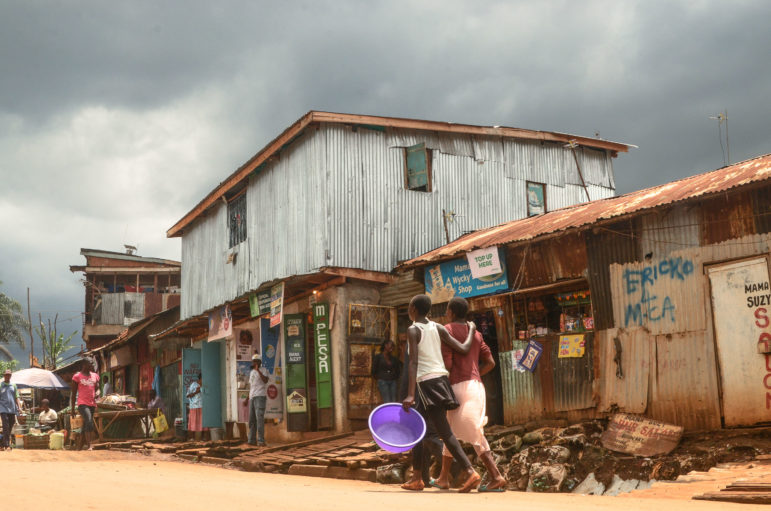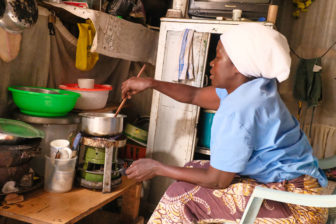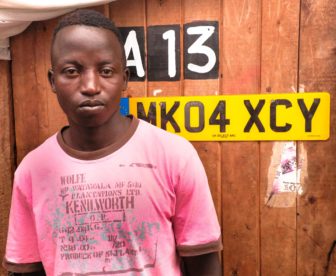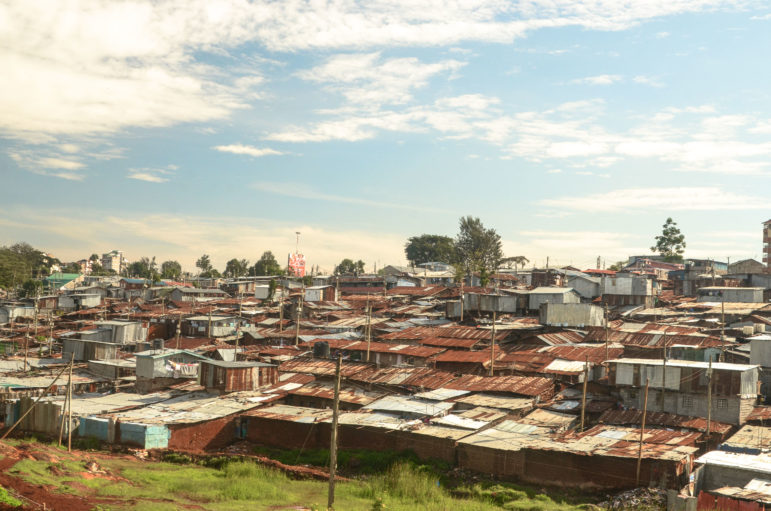
Wacera Ngunjiri
Kibera is the largest slum in Nairobi, housing more than 250,000 of the 2.5 million slum dwellers in the city of 4 million.
This story is the third in a five-part series about displacement and the advocates who are battling it around the world.
* * * *
52-year-old Nancy Kagwa has not known any home other than in Kibera, dubbed Africa’s largest slum. The mother-of-two was born there, at the heart of Kenya’s vibrant capital city, Nairobi.
The city and country have the blessing—and the curse—of being highly consumer-driven. There are increasing inequalities between the elite and the underprivileged. For instance, access to basic needs such as water and electricity remains a preserve for certain quarters of the capital and her territories.
In Kibera, many people like Kagwa live in extreme poverty, earning less than $1 a day, and the living conditions are harsh. However, this is changing in some parts of Kibera, where well-constructed houses are cropping up and roads are being built.

Wacera Ngunjiri
Nancy Kagwa
This is not good news for some of the residents living here. The construction projects are aimed at improving the livelihoods of the Kibera slum dwellers, but many of them will end up being displaced. For instance, a bypass road is being constructed to connect two other roads. It will cut through the slum, splitting the informal settlement in two. This means that thousands of the slum dwellers will be rendered homeless.
For Kagwa, who was among the many Kenyans uprooted by the unrest that followed the 2007 national election, the thought of being moved again is agonizing.
“During the post-election violence, we were displaced, but I still came back to Kibera because this is the place I’ve always called home. But now they are planning to demolish our homes and we still haven’t recovered from the post-election violence,” Kagwa says.
A promise of improvement, unkept
Nairobi is Africa’s 14th largest city with a population of over 4 million people. It is home to Africa’s biggest slum, Kibera, which houses over 250,000 of the 2.5 million slum dwellers in the city.
To improve the lives of slum dwellers, the Kenya Slum Upgrading Project (KENSUP) was created in 2009 by the Kenyan Ministry of Housing with the support of UN-Habitat and several other donor organizations.
The 15-year KENSUP scheme was expected to improve security, housing and economic prospects for 5.3 million urban slum dwellers by 2020. It involved the construction of 45,000 house units annually, the first phase targeting the people in Kibera. But change in Kibera can cause painful conflict, often along racial and economic fault lines.
“I thought I was going to be evacuated to a better home, [but] things changed,” says one resident, Benson Karanja, 22. My house’s number was changed and since then we were told things had changed. Our rent fee was increased from $10 to $15 every month and if I don’t pay that amount, I was threatened that I’d find my things moved out of my house.”

Under KENSUP, slum dwellers were told that their shanties would be demolished and they’d be relocated to new, government-built housing. But Karanka says what he sees now are other people, who are not from the slums, living in the houses that were meant to be theirs.
“I was here when these well-constructed houses were being built. We were told that our shanty houses were going to be demolished. We were to move from these smaller houses to well-constructed houses. However, those well-constructed houses are already full and I can even see Sudanese, and Ethiopians,” he says. “We, the people who were expected to move into those houses did not move. We haven’t gotten any help. They still want to demolish our small houses even before we get to the newly constructed houses. So, the government hasn’t really helped us.”
The flagship of KENSUP rises up behind Kibera, a goliath multi-storied concrete building called “The Promised Land” by local residents. The apartments inside are heavily subsidized and provide formalized services that slums lack like water, sanitation and electricity and slum dwellers were to occupy these houses.

Wacera Ngunjiri
Benson Karanja
After the building opened in 2013, a nagging problem arose. Slum residents who were relocated to The Promised Land began leaving their new homes and moving back into Kibera. Nairobi’s middle class swooped in, searching for affordable housing in a city with skyrocketing rents. Many secured apartments in the new buildings through the informal systems of bribery that dictates a great deal of life in Kenya.
“They were meant to be our houses but they were taken over by outsiders,” Karanja says.
The turnover occurred primarily because slum dwellers who moved into the establishment could no longer raise the monthly mortgage, forcing them to rent out the houses to make enough to maintain their control of the new space and still live in their slum houses.
Many Kibera residents who were given apartments through the program saw a business opportunity and rented their flats to middle-class tenants at four and five times the subsidized rate. They then moved back to the slum with extra money in their pockets.
A lack of trust

Wacera Ngunjiri
'The Promised Land'
While the economy of Kenya is a beacon among her peers, social inclusion remains elusive, particularly because of political factors that have come into play since the introduction of multi-party democracy in 1990. Even further back, the social structure of Nairobi was demarcated along racial lines, in part thanks to the British colonialists.
Gentrification has most certainly accelerated as a result of Nairobi’s hastening embrace of globalization. Many aspects of the gentrification process are desirable. Who wouldn’t want to see reduced crime, new investment in buildings and infrastructure, and increased economic activity in their neighborhoods?
Unfortunately, the benefits of these changes are often enjoyed disproportionately by the new arrivals, while the established residents find themselves economically and socially marginalized. Neighborhood change is often viewed as a miscarriage of social justice, in which wealthy newcomers are congratulated for “improving” a neighborhood whose poor, minority residents are displaced by economic change.
No one is more vulnerable to the effects of gentrification than renters. When prices go up, tenants are pushed out, whether through rent hikes or evictions. When buildings are sold, buyers often evict the existing tenants to move in themselves, combine several units, or bring in new tenants paying higher rent.
Whether there are campaigns against displacement or a city has policies to safeguard affordable housing, urban experts say efforts to improve cities with cutting-edge technology can run into challenges, particularly when applied in slums.
Even in such cases, Kibera slum dwellers could use the legal system. The bill of rights in the current constitution of Kenya stipulates adequate housing as a basic right for every Kenyan. But exercising that right is complicated by the lack of an effective framework for the county’s land laws and housing policies, and the complexity presented by the fact that close to 60 percent of the city’s population lives in informal settlements.
There has been a great deal of mistrust of the government and development organizations in Kibera. A history of failed aid projects and forced evictions have left many residents feeling exploited by outsiders. The Promised Land project was able to come into play mainly because the United Nations generally has a good reputation and their projects are well known to be ones that help improve a society. UN-Habitat’s role in the Promise Land project was key to its initial acceptance by slum dwellers. According to a 2015 account, the UN handed over control of the project to the national government.
Whoever is in control, the Promised Land housing earmarked to benefit Kibera dwellers who generally live on less than a dollar a day is now a place for the middle class.

Wacera Ngunjiri
Conditions in Kibera reflect longstanding divisions in Kenyan society, some dating to colonial times.









3 thoughts on “Nairobi Slum Dwellers Feel Let Down by the ‘Promised Land’”
….and now they(government)are building skyscrapers with observation decks, how will the visitors think, when they’ll see the slums, yet Nairobi city is vibrant??
The govt needs to style up and convert Kibera from that horrible & shaggy environs, to a city within a City.
It’s unfair to treat other Kenyans unfairly. We’re all the SAME,period
Pingback: Could Changing the Way Chicken Is Sold Reduce Malnutrition in Kenya? | Fun Easy Cool
Pingback: Could Changing the Way Chicken Is Sold Reduce Malnutrition in Kenya? - ...:: AgricNation Portal::...